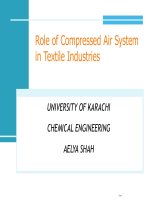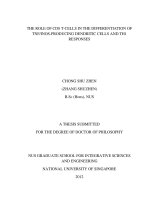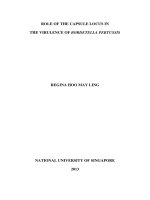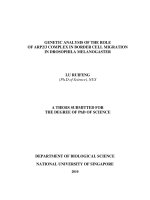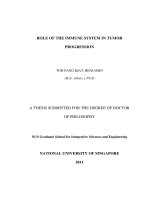Role Of Compressed Air System In Textile Industries
Bạn đang xem bản rút gọn của tài liệu. Xem và tải ngay bản đầy đủ của tài liệu tại đây (428.96 KB, 35 trang )
Role of Compressed Air System
in Textile Industries
UNIVERSITY OF KARACHI
CHEMICAL ENGINEERING
AELYA SHAH
Agenda
Introduction
Use of Compressed Air in Textile Industry
Applications
Compressed Air System
Types of Compressor
Compressor used in Textile Industry
Optimization of Air System
Minimizing Compressed Air Cost
Introduction
Compressed air, also referred to as the
"4
th
Utility" (after electricity, water & steam) is
one of the major energy consumption utility in
any industry.
Various estimates indicate that about 4,000-
5,000 MW is consumed nation wide by the
compressors and its related accessories &
support systems.
It is a well-known fact that of the life
cycle cost of any compressor, 85-90% is
towards energy and only 10-15% towards
initial investment & maintenance.
Hence, the design and selection of the right
compressor assumes great significance while
setting up your air system. It is very important on
the part of each one of us using compressed air to
understand a simple fact that "Air is free but
compressed air is not!"
Use of Compressed Air in
Textile Industry
In Textile manufacturing units, generally
following Compressed air powered pneumatic
systems are used:
Spinning machine (for control purpose through
valves and cylinders)
Loom Jet Weaving (for the insertion of weft).
Winding machine (for the purpose of splicing of
yarn)
Use of Compressed Air in
Textile Industry
Stacking Device
Printing machines
Thread Detector
Sewing Machine
Texturising
Automated
Equipment
Agitating Liquids
Cleaning
Pneumatic control
and actuators
System Cooling
Clamping
Blowing out
residual / dust
material
Sewing Needle
Conveying
Applications
Compressed Air System
The compressed air system mainly consists of:
•
Supply side
•
Distribution &
•
Demand side
Compressed air systems consist of a supply side,
which includes compressors and air treatment.
and a demand side, which includes distribution
and storage systems and end-use equipment.
A properly managed supply side will result in
clean, dry, stable air being delivered at the
appropriate pressure in a dependable, cost-effective
manner.
A properly managed demand side minimizes
wasted air and uses compressed air for
appropriate applications.
Compressed Air System
compressed air sub system
As such the compressed air system has following six
major sub systems
•
Air compressors
•
Controls
•
Air Quality
•
Storage
•
Distribution
•
Demand (consumption)
The compressed air generated by compressor
is stored in the Air-receiver of sufficient capacity
to smoothen fluctuations in the supply of
compressed air vis-a-vis demand from
individual consumption points (machines).
The air receiver helps also in cooling of air and
this facilitates removal of much of the moisture
in the air which is harmful for the pneumatic
system.
Air-receiver
For large users/bigger compressors air dryer
units are provided.
The air dryer units of two types are
normally employed in the mills.
1.heatless dryer
2.refrigerated air dryer.
Air-dryer
Although, the refrigerated air dryer has
higher initial cost, it has less operational cost
than the heatless type. This is because in
heatless dryer about 10-12% of compressed
air is lost in purging thereby wasting costly
electrical energy.
The air dryer helps in making the
compressed air almost 100% dry – which is
essential for some machines such as Air jet
looms
Air-dryer
As regards air distribution network, it
should be ensured that pressure drop should
not be more than 0.5 kg/cm2in the longest
line.
The pipe sizes are to be decided based on
this consideration. Also the pipe lines should
be of minimum length with less bends and
fittings.
This will ensure minimum wastage of
electrical power.
Air distribution
For the proper and trouble free operation
of pneumatic systems provided for the
machines, it is essential to ensure filteration,
pressure regulation and lubrication of the
compressed air.
The filteration is ensured by providing
filters in the pipe line after the air receiver.
These can remove dust particles upto 5
micron size.
Air filter
Pressure regulation i.e. maintaining the
desired air pressure for the machines used
is achieved by the use of air pressure
regulator.
Pressure regulation
For reducing friction and wear
and tear and preventing corrosion,
proper lubrication of compressed
air is necessary. This is achieved by
the ‘oil-fog’ air line lubricator.
Lubrication
TYPES OF COMPRESSOR:
TYPES OF COMPRESSOR
Air compressors are mainly classified in two
types based on their construction & operation:
1. Positive displacement (Reciprocating &
Rotary compressors)
2.Dynamic type (Centrifugal & Axial flow
compressors)
Positive-Displacement
Compressors
In the positive-displacement type, a given
quantity of air or gas is trapped in a
compression chamber and the volume which
it occupies is mechanically reduced, causing
a corresponding rise in pressure prior to
discharge. At constant speed, the air flow
remains essentially constant with variations
in discharge pressure.
Reciprocating compressors
It work like bicycle
pumps. A piston, driven
through a crankshaft and
connecting rod by an
electric motor, reduces the
volume in the cylinder
occupied by the air or gas,
compressing it to a higher
pressure.
Double-acting reciprocating compressors
are generally water-cooled and with multi-
stage versions are usually considered to be the
most efficient air compressors (100 hp to 250
hp). These however, come with high initial &
installation costs and higher maintenance as
well.
Single-acting reciprocating compressors are
generally air-cooled and available in the
smaller hp sizes (1 hp to 50 hp). However, such
compressors are generally less efficient than
the other types.
Screw compressors
Screw compressors are available as oil-
flooded (lubricated) single or multistage
(generally from 15 hp to 500 hp) but have lower
operating efficiencies at part-loads and also
high unload power, which could become the
key factors in reducing your operating
efficiencies. However, incorporating VFD
(variable frequency drive) or HPM motor
(hybrid permanent magnet) would make these
compressors efficient throughout the operating
range.


